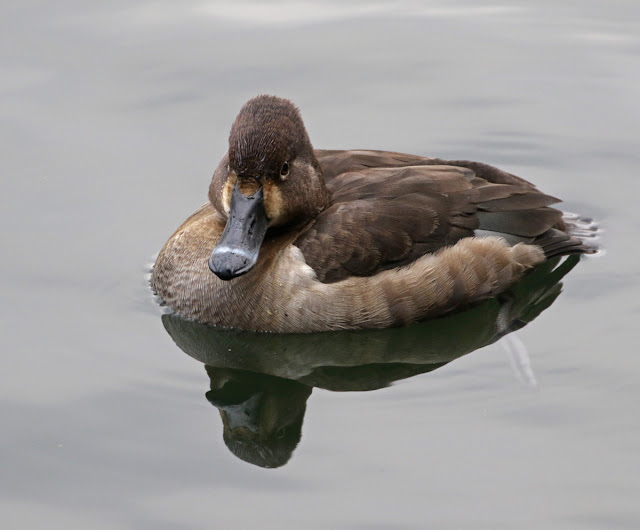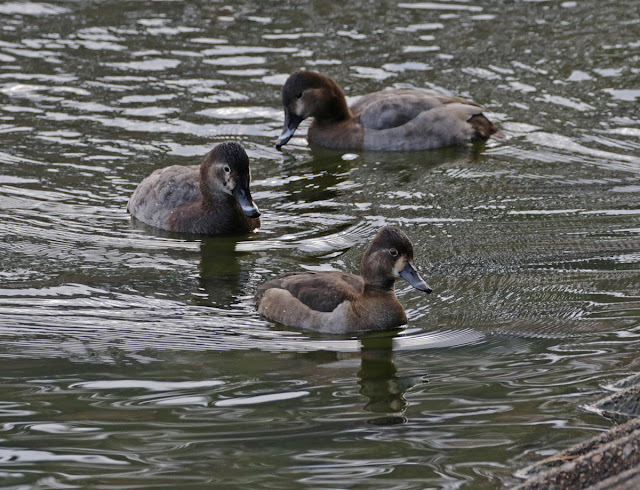Back in the 80's I walked across the tarmac to transit in Samarkand Airport building on several occasions. Does this mean I've been to Uzbekistan? Well, politically no but geographically yes I suppose it does. Similarly I've stood on the deck of a ferry while docked in Sendai numerous times, almost touching distance to Miyagi but until last week it had remained one of two Japanese prefectures I'd never set foot in.
Miyagi is a bit out of the way if you're based in Kyoto, whenever I head north I drive the quicker Japan Sea route rather than along the Pacific side of the country. However I finally made the pilgrimage to see the goose flocks of Miyagi and ticked the prefecture off my list.
It's still rather early in the season to see the spectacle of the geese flying up from Lake Izunuma, there will be five times the current number of geese pretty soon. So why go now? One reason is that it's still shirt sleeve weather up there. Another being Japan's first record of Red-breasted Goose! This was a fairly open secret as I drove up but during the three days I was there it became increasingly obvious the news was already spreading rapidly even in the Kansai area. So I don't think it can be considered a secret any longer.
Even if the goose numbers haven't peaked, the sight is still very impressive. If Kyushu has the dawn flight of cranes at Arasaki and Hokkaido has the astonishing sight of flocks of sea eagles sitting like gigantic sparrows in the trees of Rausu town, then this must be Honshu's contribution to outstanding birding sights of Japan.
The geese start to lift from the lake pre-dawn and just keep on coming, wave after wave, throughout the sunrise.
The vast majority of the geese are Greater White-fronts, Taiga Beans are numerous enough to be found fairly easily but other species can take time depending on your luck. I was finding flocks of geese as far as 30km form the lakes and presumably they spread out in all directions, so that's a lot of ground to cover.
I arrived at midday Thursday after a 12-hour drive and I spent the afternoon around Lake Izunuma, where I'd been informed the Red-breasted is sometimes seen. No luck with that but an immature Snow Goose was the first of the possible species which, with luck/effort, can be seen here. Snow and Cackling are still extreme rarities in western Japan (I've only seen one of each down here), though records may increase as the wintering population of these two species is increasing in northern Honshu. Lesser White-front is rare but more frequent in western Japan and it also has a larger Izunuma population compared to the other two species.
 |
| The first of two Greater Snow Geese; this bird could be seen without much effort as it was always in the general Lake Izunuma area and of course because it stood out like a sore thumb. |
 |
| I had been curious whether I'd see any difference between the Miyagi and Shiga Taiga Bean Geese but the appearance of Miyagi birds was both very consistent and a good match for majority of the Shiga population. |
On Friday morning I was positioned pre-dawn at the western end of Lake Izunuma with a crowd of photographers waiting for the geese to leave the roost.
 |
| I know I said shirt-sleeve weather... but this was early. Still, I think they it's a bit over the top, I thought a sweater quite enough. I can imagine it'll be pretty brutal in a couple of months though. |
Most geese headed off north west and I followed hoping to find the Red-breasted. I didn't find it but I know now I was on the right track. Later in the day, and a good few kilometres away I came across this rather attractive Greater White-front. With my very limited knowledge of colour aberrations I think this is an example 'pastel' dilution.
 |
| A rather attractive ghostly Greater White-front. |
On the same fields as light was failing I finally connected with my only Cackling Geese of the trip, unfortunately I couldn't get closer than this and they weren't in these fields the following day.
 |
| A record shot of my only Cackling Geese of the trip, found in the nick of time after the sun had set. |
I decided not to watch the post-roost dispersal on Saturday morning. There were other places I wanted to try, particularly the fields where the Cackling had been the previous day then further west beyond Lake Naganuma where I'd already found large concentrations of geese.
At the first port of call there were about 250 Whooper swans, the largest gathering I saw, and a Snow Goose close to the track (I think this was the same bird as yesterday), then more geese stretching away across the fields. This was so so enjoyable I spent about 2.5 hours watching these birds, far longer than I had intended, before making my way to Naganuma.
We get large numbers of Tundra Swans in western Japan but Whoopers aren't common. It's a pity really, I find the first winters very attractive, more so than either the adults or similarly aged Tundras.
After checking through the flocks near Naganuma I pushed further west and came across the only Lesser White-fronts of the trip. I counted 35 birds on the first sweep but I soon noticed more distant birds plus others flying over and it's probably no exaggeration to say there must have been 50 birds in small parties mixed in with the Greater White-fronts in that area. There was also another immature Snow Goose, this definitely was a different bird.
 |
| Six Lesser White-fronts with two Greaters (right). |
 |
| Most Lessers were in fields with longer vegetation, coincidence or preference I don't know. |
 |
| Their high-pitched flight calls made them easily recognisable at any distance. |
At this point I had planned to head back to the Friday morning area and right on cue I received a message to say that's where the Red-breasted was! Sad to say, I never made it. Someone didn't stop at a crossroads (it was completely flat and completely open!), hit my van just behind the rear wheel and I went rolling down the road. Not long after I'd climbed up and out through the skyward passenger side door and dropped down to the road the ambulance arrived. That was fast! It seemed I had no option but to go to hospital, they were very insistent, which meant I left all my belonging, including phone and wallet inside the van.
After wasting time at the hospital... I was fine apart from my nose, the police kindly chauffeured me to the correct wrecker's yard, at the second attempt, where I could collect my money, phone and optical gear from the dead van, then sadly back to Tome to catch a bus to Sendai (that with the port I'm very familiar with, as mentioned earlier) and then shinkansen back to Tokyo/Kyoto. The policeman had suggested a taxi to Sendai...
taxi to Sendai! good grief how much do they get paid.
So the upshot is my wife's new van is dead, my wife's angry... no no no... my wife's apoplectic, and I suffered a very painful dip.
And now, just one last Japanese prefecture to visit; I wonder what it has in store.

















































